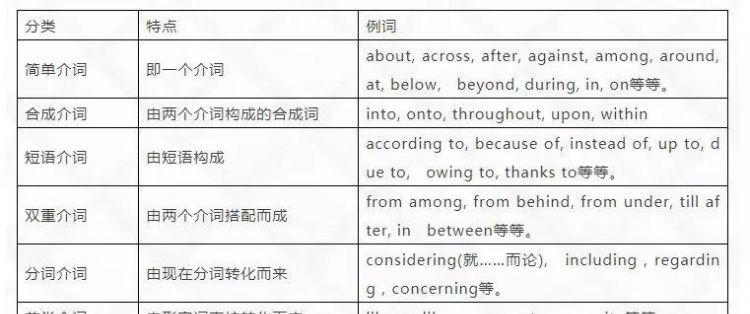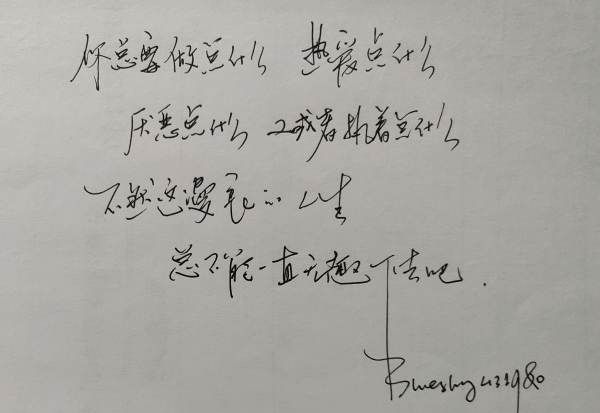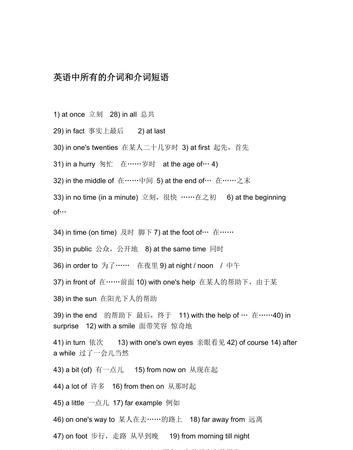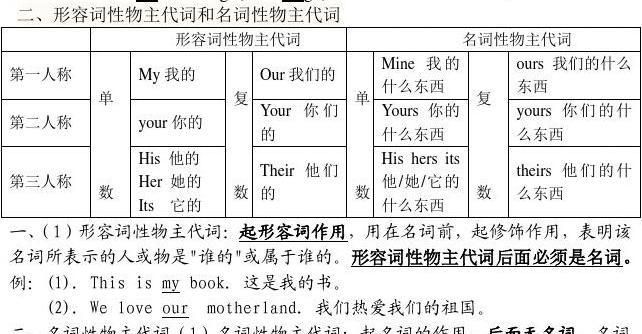本文目录
介词短语可以充当什么成分
介词短语指的是介词后面加上名词或者代词组成的短语。

英语里面什么叫介词短语
介词短语,一般指的是介宾短语。介词加名词组成的短语,例如:by accident, by the way, in return,当然也有其他形式的结构组成的介词短语。

名词性物主代词
宾格是人称代词的一种形式
(我me 你you 他him 她her 它it 他们 them)
用在动词以后,比如He asks me to study hard。me就是宾格
或者用在介词后,比如I buy a book for him。him是宾格
代词是代替名词的一种词类。大多数代词具有名词和形容词的功能。英语中的代词,按其意义、特征及在句中的作用分为:人称代词、物主代词、指示代词、自身代词、相互代词、疑问代词、关系代词和不定代词八种。
一、人称代词是表示"我"、"你"、"他"、"她"、"它"、
"我们"、"你们"、"他们"的词。人称代词有人称、数和格的变化,见下表:
数 单数 复数
格 主格 宾格 主格 宾格
第一人称 I me we us
第二人称 you you you you
he him they them
第三人称 she her they them
it it they them
They picnicked in the woods. 他们在树林里野餐。
Don’t walk on the grass. 不要在草坪上走。
句中的in the woods和on the grass均为介词短语。

初中三年介词加名词的短语有哪些
1.in+语言/颜色/衣帽等,表示使用某种语言或穿着……。
2.in + Row/ Team/ Class/ Grade等,表示“在……排/队/班级/年级”等。
3.in the morning/ afternoon/ evening/ 表示“在上午/下午/傍晚”等一段时间。
4.in the desk/ pencil-box/bedroom 等表示“在书桌/铅笔盒/卧室里”。
5.in the tree表示“在树上 (非树本身所有)”;on the tree表示“在树上(为树本身所有)”。
6.in the wall表示“在墙上(凹陷进去)”;on the wall表示“在墙上(指墙的表面)”。
7.at work(在工作)/at school(上学)/at home(在家)应注意此类短语中无the。
8.at + 时刻表示钟点。
9.like this/that表示方式,意为“像……这/那样”。
10.of短语表示所属关系。
11.behind/ beside/ near/ under+ 名词等,表示方位、处所。
12.from与to多表示方向,前者意为“从……”,后者意为“到……”。
另外,以下这些短语也必须掌握。如:on duty, after breakfast, at night, at the door, in the middle, in the sky, on one’s bike等。
初中英语知识总结--短语、词组和重点句型归纳短语、词组归纳 由动词开头构成的短语、词组很多。复习时应分类处理: 一、动词+介词 1.look at…看…,look like … 看上去像……, look after …照料… 2.listen to…听…… 3.welcome to…欢迎到…… 4.say hello to …向……问好 5.speak to…对……说话 此类短语相当于及物动词,其后必须带宾语,但宾语无论是名词还是代词,都要放在介词之后。如: This is my new bike. Please look it after.(×) This is my new bike. Please look after it.(√) 二、动词+副词 “动词+副词”所构成的短语义分为两类: A.动词(vt.)+副词 1.put on 穿上 2.take off脱下 3.write down记下 此类短语可以带宾语,宾语若是名词,放在副词前后皆可;宾语若是人称代词,只能放在副词的前面。试比较: First listen to the tape, then write down the answer/write the answer down. (√) First listen to the answer, then write down it.(×) First listen to the answer, then write it down.(√) B.动词(vi)+副词。 1.come on赶快 2.get up起床 3.go home回家 4.come in进来 5.sit down坐下 6.stand up起立 此类短语属于不及物动词,不可以带宾语。 三、其它类动词词组 1.close the door 2.1ook the same 3.go to work/class 4.be ill 5.have a look/seat 6.have supper 7.1ook young 8.go shopping 9.watch TV/games 10. play games. 介词短语聚焦 “介词+名词/代词”所构成的短语称为介词短语。现将Unitsl-16常用的介词短语按用法进行归类。 1.in+语言/颜色/衣帽等,表示使用某种语言或穿着……。如:in English,in the hat 2.in + Row/ Team/ Class/ Grade等,表示“在……排/队/班级/年级”等。 3.in the morning/ afternoon/ evening/ 表示“在上午/下午/傍晚”等一段时间。 4.in the desk/ pencil-box/bedroom 等表示“在书桌/铅笔盒/卧室里”。 5.in the tree表示“在树上 (非树本身所有)”;on the tree表示“在树上(为树本身所有)”。如:There are some in the tree. There are many apples on the trees. 6.in the wall表示“在墙上(凹陷进去)”;on the wall表示“在墙上(指墙的表面)”。如:There’re four windows in the wall, and there is a map on the back wall. 7.at work(在工作)/at school(上学)/at home(在家)应注意此类短语中无the。 8.at + 时刻表示钟点。如:at six, at half , past ten. 9.like this/that表示方式,意为“像……这/那样”。 10.of短语表示所属关系。如:a picture of a classroom, a map of China. 11.behind/ beside/ near/ under+ 名词等,表示方位、处所。如:beside/ near the door, under/ behind the tree. 12.from与to多表示方向,前者意为“从……”,后者意为“到……”。如:from one to ten, (go) to school/ bed/ work. 另外,以下这些短语也必须掌握。如:on duty, after breakfast, at night, at the door, in the middle, in the sky, on one’s bike等。 重点句型大回放 1.I think…意为“我认为……”,是对某人或某事的看法或态度的一种句型。其否定式常用I don’t think…,如:I think he’s Mr Zhinag. (L17)I don’t think you are right. 2.give sth. to sb./ give sb. sth. 意为“把……给……”,动词give之后可接双宾语,可用这两种句型;若指物的宾语是人称代词时,则只能用give it/ them to sb. 如: His parents give him a nice purse./His parents give a nice purse to him. Give it to Mr Hu.(L57) 3.take sb./ sth. to…意为“把……(送)带到……”,后常接地点,也可接人。如: Please take the new books to the classroom. 4.One…, the other…/One is…and one is…意为“一个是……;另一个是……”,必须是两者中。如:One is red and one is grey.(L50)或 One is red,, the other is grey. 5.Let sb. do sth. 意为“让某人做某事”,人后应用不带to的动词不定式,其否定式为Don’t let sb,do sth.,或Let sb. not do sth. 另外,Let’s 与Let us的含义不完全相同,前者包括听者在内,后者不包括听者在内,如:Let’s go for a walk./Let us try once more, please. 6.help sb. (to) do sth./help sb. with sth.意为“帮助某人做某事”,前者用不定式作宾补,后者用介词短语作宾补,二者可以互换。如:Let me help you find it.(L42)/Let me help you with it. 7.What about…?/How about…?意为“……怎么样?”是用来询问或征求对方的观点、意见、看法等。about为介词,其后须接名词、代词或V-ing等形式。如:What/How playing chess? 8.It’s time to do…/ It’s time for sth. 意为“该做……的时间了”,其中to后须接原形动词,for后可接名词或V-ing形式。如:It’s time to have supper. =It’s time for supper. 9.like to do sth./like doing sth.意为“喜欢做某事”,如:Li Lei and his friends like to play in the tree house. (L 43)前一种句型侧重具体的一次性的动作;后一种句型侧重习惯性的动作,试比较: Tom likes swimming, but doesn’t like to swim this afternoon. 10.ask sb.(not) to do sth. 意为“让某人(不要)做某事”,其中ask sb.后应接动词不定式,如: Ask your friends to guess what is in it. (L44) 11.show sb. sth. / show sth. to do. 意为“把某物给某人看”,该句型的用法同前面第2点。如: Show your friend your family photo.(L36)/Show your family photo to your friend. 12.introduce sb. to sb. 意为“把某人介绍给另一人”;introduce to sb.则是“向某人作介绍”。如:Introduce your family to her.
1.初中英语教材中共出现近500个词组,其中有一部分为常用词组,要求能熟练运用.
2.在学习中,要注意词组的积累,特别要注意介词词组和短语动词的积累.
3.对固定词组的意义,切不可望文生义.例如,动词look愿意为“看”,但look after意为“照料”,look up (a word in a dictionary)意为“(在词典中)查找(单词)”.
4.要十分注意固定词组中冠词的使用.有时冠词可引起词义的变化,例如,go the school意为“上学”,而go to the school意为“到学校里去”;take place意为“发生”,而take the place意为“取代”.有些词组中须用冠词,而另一些则不用.例如,in the evening, at night.
一、动词词组(包括短语动词)、介词词组和其他词组
(一)由be构成的词组
***/question/afe0a977df40457add5aa4ef7345c899.html

以上就是关于名词或代词加介词短语 ,介词短语可以充当什么成分的全部内容,以及名词或代词加介词短语 的相关内容,希望能够帮到您。
